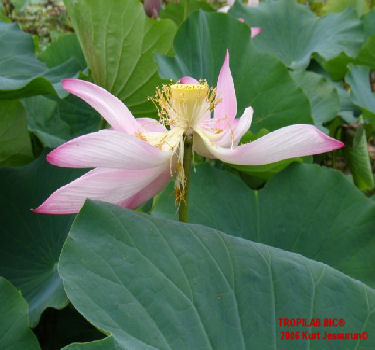Overview

All parts of the Lotus (Sacred Lotus) are used medicinally; however we use only the flowers (petals) and leaves in the
herbal tincture and medicinal tea applications
Sacred Lotus is an aquatic perennial, originally from Indonesia and India.
This plant is also growing abundantly in Suriname.
The plant has hepatoprotective effects (prevents damage to the liver), due to its potent antioxidative
properties.
Constituents
The phytochemicals: alkaloids (benzylisoquinoline, bisbenzylisoquinoline, liensinine, negferine, isoliensinine,
aporphine, nuciferine), flavonoids, quercetin, isoquercitrin, catechin and leukodelphinidin. Flavenol (miquelianin).
Pharmacology

Findings suggest that Lotus leaf extract and its active constituent catechin are useful in the control of hyperglycemia
in non-insulin-dependent diabetes mellitus through their action as insulin secretagogues (substance that promotes secretion).
Catechin significantly and dose-dependently enhanced insulin secretion.
The plant has a traditional history in the treatment of cancer; research has isolated certain compounds from the
plant that show anticancer and anti HIV activity.
Applications
Promotes homeostasis, stops bleeding.
Anticancer; Astringent; Cardiotonic; Febrifuge; Hypotensive; Miscellany; Resolvent; Stomachic; Tonic; Vasodilator.
In traditional medicine, the flowers and stamens are used in the treatment of premature ejaculation.
The flowers
are recommended as a cardiac tonic. A decoction of the floral receptacle is used in the treatment of abdominal
cramps and bloody discharges.
Stamens are used in treating urinary frequency, premature ejaculation, haemolysis,
epistasis and uterine bleeding.
These parts are astringent, cardiotonic, febrifuge, hypotensive, resolvent, stomachic, styptic, tonic and vasodilator.
Leaf juice is used in the treatment of diarrhea.
A decoction of the flowers is used in the treatment of premature ejaculation and as a cardiac tonic.
A decoction of the floral receptacle is used in the treatment of abdominal cramps and bloody discharges.
The flower stalk is haemostatic.
It is used in treating bleeding gastric ulcers, excessive menstruation and post-partum hemorrhage.
Stamens are used in treating urinary frequency, premature ejaculation and uterine bleeding.
A decoction of the fruit is used in the treatment of fever and heart complaints.
The seeds are hypotensive, sedative and vasodilator. They have shown to lower cholesterol levels and to relax the
smooth muscle of the uterus. They are also used in the treatment of poor digestion, enteritis, chronic diarrhea,
insomnia.
The plumage and radicle are used to treat thirst in high febrile disease, hypertension, insomnia and restlessness.
The root starch is used in the treatment of diarrhea and dysentery.
It is also taken internally in the treatment of hemorrhages, excessive menstruation and nose bleeding.
The root nodes are used in the treatment of nasal bleeding, haemoptysis and functional bleeding of the uterus.
Sacred lotus has mild psychoactive properties.
Dosage
Tincture (petals):: 1 -3 ml per day
Infusion (herbal leaf tea): 1 – 2 cups daily.
Naturally caffeine free.
Reference
Antioxidant principles of Nelumbo nucifera stamens.
Jung HA, Kim JE, Chung HY, Choi JS.
Faculty of Food Science and Biotechnology, Pukyong National University, Busan 608-737, Korea.
Extract of lotus leaf (Nelumbo nucifera ) and its active constituent catechin with insulin secretagogue activity.
Huang CF, Chen YW, Yang CY, Lin HY, Way TD, Chiang W, Liu SH.
Graduate Institute of Chinese Medical Science, School of Chinese Medicine, College of Chinese Medicine, China.
The above presentation is for informational and educational purposes only.
It is based on scientific studies (human, animal, or in vitro), clinical experience, or traditional usage.
For many of the conditions discussed, treatment with prescribed (RX) or over - the - counter (OTC) medication is also available.
Consult your doctor, practitioner, and/or pharmacist for any health problem and before using dietary supplements
or before making any changes in prescribed medications.
|

